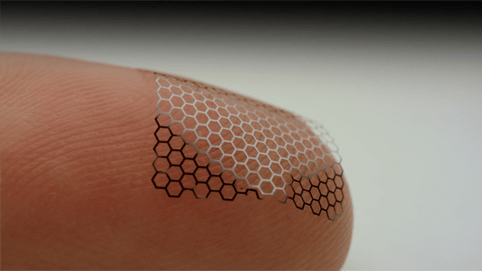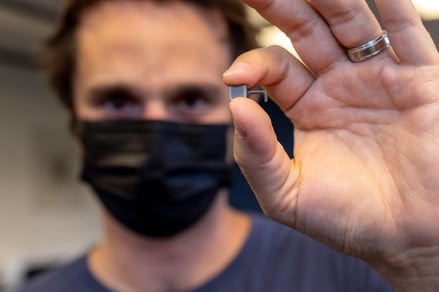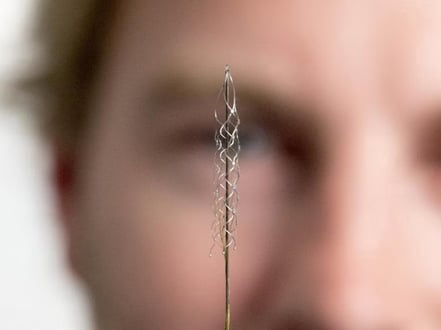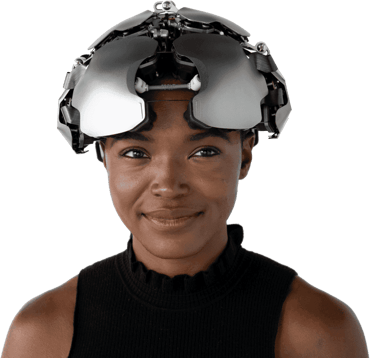
Are you ready to connect your brain to the cloud?
Technologist and futurist Ray Kurzweil predicts that in the early 2030s we will achieve networking the human neocortex with the cloud over high-bandwidth connections.
Near-term implications mean that those suffering from neurological disorders such as spinal cord injuries, epilepsy, vision loss and hearing loss may ultimately restore sensory and movement function.
The longer-term implications are out of the pages of science fiction: being able to “think and Google,” connecting your senses and actions to a robotic avatar, connecting empathically with other humans, and gaining superhuman intelligence, just to name a few.
Companies like Neuralink (famously founded by Elon Musk), Paradromics, and Blackrock Neurotech, utilize micron-scale threads that are inserted into areas of the brain that control movement and perceive senses. Others like Kernel are building the next generation of brain measurement systems using wearable sensors that offer high-quality neural signals and full-head coverage.
The field is generally known as Brain-Computer Interface or BCI. This Metatrend is enabled through the convergence of material sciences, compute, machine learning, and robotics.
In today’s blog, I’ll discuss the technology’s implications, a brief history of BCI technology, and the latest developments from some of the leading BCI companies.
Let’s dive in!
BCI USES & IMPLICATIONS
The implications of high-bandwidth BCIs are multiple and significant. Perhaps the best way to think about them is in terms of timeframe: near-term and long-term.
Near-term Implications
Here are 2 examples of the most immediate and obvious applications of BCIs:
#1. Stroke patient uses a BCI to write: Neuroscience researchers at the University of California, San Francisco treated a stroke patient using a 128-electrode brain implant, referred to as a “subdural electrode array” (provided by Blackrock Neurotech). During an 81-week period, using only his thoughts (his brainwaves read by an AI) he was able to write messages including “I am feeling hungry” and “Please bring my glasses.”
#2. Paralyzed patients can now “type” on an iPhone: A patient suffering from an advanced stage of amyotrophic lateral sclerosis (ALS), a debilitating disease that affects motor activity, recently demonstrated that he can carry out text exchanges with other people using just his thoughts, enabled by software that integrates his iPhone and his implantable BCI.
Long-term Implications
Beyond the immediate medical implications, there are two proposed, longer-term implications worth noting: BCI technology’s ability to increase the cognitive capacity of individuals, and how the technology will help augment humans compared to the capabilities of AI.
#1. Increasing Human Intelligence: What if you could “think and Google”? How would your intelligence change if you could remember everything?
Imagine connecting your mind to the cloud—with the entirety of human knowledge accessible in an instant. With this ability, what kinds of new and profound innovations, solutions, and theories will emerge? What new businesses will we create?
Now imagine that billions of people have this ability.
For companies, countries, or individuals there’s nothing of greater value than the intelligent use of your team.
What if we could interconnect all of our minds?
Imagine a future society in which communities (or the totality of humanity) are connected to each other through high-bandwidth BCIs, enabling extensive sharing of feelings, memories, and thoughts. Linking 8 billion minds via the cloud could help us reach a state of transformative human intelligence, paving the way for what could be the most historic period of peace and collaboration in history. It’s a concept called the “Meta-Intelligence” that I write about in my book The Future is Faster Than You Think. Crazy you might say, but don’t forget that each of us "humans" is made up of 40 trillion individuals human cells, each alive on its own, connected and collaborating to create YOU.
#2. The Promise of Augmented Humans: For those who argue that AI is dangerous and who worry about the technology dominating humanity (the Terminator scenario), they should take comfort in the notion that it may not be “AI versus humans,” but rather “AI versus augmented humans.”
It’s about the merger of AI and humans—human-machine collaboration through BCI technology that will enable humanity to progress and evolve to the next level.
While this sounds like science fiction, this is happening. In fact, we have already outsourced much of our memory and knowledge base and capabilities to our smartphones. They are always within reach, and although they may not be inside you, they are very much a part of you.
We can see the benefits of human-machine collaboration by looking at chess.
Chess was one of the first areas in which computers outperformed humans, and AIs are continuing to improve.
But the field of advanced chess, also called “cyborg chess,” where humans and AI partner and compete as a team, multiple matches have shown that a human-AI team is superior to an AI chess engine alone.
Before looking at the companies that will help us create this future, it helps to understand the history and evolution of BCI technology.
brief history of bci technologies
Scientists and engineers have been developing some version of a BCI since the 1950s. But it wasn’t until the 1970s when the term “brain-computer interface” was coined by Professor Jacques Vidal of UCLA, who directed a project to analyze EEG signals, from electrodes attached to the scalp.
Two of the key developments in the evolution of BCI technology are the success of cochlear implants and the use of deep brain stimulation.
Cochlear Implants
The first breakthrough in the development of neural interface technology has been the development and success of cochlear implants.
Cochlear implants are surgically implanted electrodes that bypass damage or underdevelopment of the middle ear or inner ear to directly stimulate auditory nerves and restore hearing. They work through an external speech processor that hears sounds and converts them to electric signals. Those signals are then transmitted to the cochlea to stimulate the auditory nerve fibers, thereby bypassing the sensory parts of the ear.
Since the US FDA first approved cochlear implants for use in the 1980s, hundreds of thousands of people use this invasive neural interface to help them hear.
Deep Brain Stimulation
The use of deep brain stimulation (DBS) marks another key milestone in the evolution of BCI technology.
DBS involves implanting electrodes into specific areas of the brain. These electrodes create electrical impulses that can regulate abnormal brain activity or adjust for chemical imbalances in the brain. Stimulation of the various brain areas is controlled by a pacemaker-like device that is placed under the skin in a person’s chest.
DBS is used to treat a range of conditions, including movement disorders such as Parkinson’s disease and psychiatric conditions including obsessive-compulsive disorder.
According to the National Institutes of Health, more than 160,000 people globally have undergone DBS.
TODAY'S LEADING BCI COMPANIES
Here are brief profiles of the 5 companies that I believe are developing the most promising BCI technologies.
#1. Blackrock Neurotech

Blackrock Neurotech's new BCI called Neuralace is thinner than an eyelash
Blackrock Neurotech, founded in 2008, is the world's leading platform company for BCI technology, at the forefront of making BCI in humans a reality. Blackrock is the only company in the world with an implantable penetrating array with almost 100 electrodes per device that is already FDA cleared and used in humans. Some patients even use several devices.
To date, there are 36 human patients around the world who are living with a BCI in their head, and 32 of those use Blackrock's technology.
"Dozens of human patients are currently using our implants and technology to accomplish things directly with their minds that were unimaginable ten years ago,” said Marcus Gerhardt, CEO and Co-founder of Blackrock. “We have spent over a decade developing our technology with several hundred of the world's leading research institutions and over 20 clinical partner centers."
Blackrock Neurotech has powered a wide range of "firsts" in human BCI applications. For example, the first to provide tetraplegic patients the ability to control robotic limbs directly from and with the brain; and the first to enable ALS patients, even completely locked-in ones, to communicate again via an auditory speller, directly controlled by their mind.
In November 2022, Blackrock unveiled its new, next-generation BCI called Neuralace.
Restoring memory and vision and treating mental health disorders such as depression require BCIs that can interface with more neurons, and this is what Blackrock’s new BCI is designed to address.
Neuralace has more than 10,000 channels, all on a flexible lace-structured chip that’s thinner than an eyelash.
Blackrock will make the Neuralace available to the neuroscience research community in 2024 and plans to have its first demonstrations of the BCI as a visual prosthesis in humans by 2028.
#2. Neuralink

Neuralink's BCI aims to be "a Fitbit in your skull"
Neuralink, founded by Elon in 2016, is perhaps the best known BCI company.
In November 2022, Elon and the Neuralink team gave a presentation with updates on their roadmap for connecting—and eventually merging—our minds with machines.
During the presentation, Elon said that the first 2 applications of the Neuralink BCI would be: (1) to help people with paralysis more effectively use their digital devices, and (2) to restore vision in those who’ve lost their eyesight. In fact, the team showed a video demonstration of how Neuralink’s BCI has been used to stimulate visual stimulation in a monkey’s brain.
The current version of Neuralink’s device, called Link, is about the size of a quarter and contains roughly 1,000 electrodes. These electrodes, or channels, are capable of recording and stimulating neurons.
Back in 2020, the Neuralink team showcased a live pig with a Neuralink chip implanted in its brain, showing the live brain signals as the pig walked on a treadmill. And in 2021, Neuralink highlighted a video of a macaque playing Pong hands-free using its Neuralink BCI.
In November 2022, the team said that it’s working on an updated version of the BCI that will be roughly the same size but contain up to 4,000 electrodes.
One of the key innovations that Neuralink plans to use is a surgical robot that inserts the electrodes into the brain through a small hole in the skull “as easy as someone receives Lasik surgery.”
So, when can we expect to see the Neuralink BCI in humans?
Elon said that the company has begun submitting paperwork for a clinical trial to the US FDA, and he hopes to have a Neuralink BCI implanted in a human patient in 6 months.
#3. Paradromics

Paradromics' BCI consists of over 1,600 Platinum-iridium microwires
Paradromics is on a mission to create a next generation BCIs that will help people with disorders ranging from paralysis to speech impediments.
The company’s implantable device is a 1 cm square chip that consists of 1,600 Platinum-iridium microwires protruding in an array from one side of the chip.
This “brain chip” is placed in the layer between the pia and dura mater––protective membranes that overlay the brain. When the chip is placed onto the brain, those 1,600 Platinum-iridium microwires penetrate only 1.5 mm deep into the neocortex.
These chips transmit data into and out of the upper layer of the brain, and then transport the data to a module that is implanted just below your skin on the subject’s chest. Because everything lies just under the skin, no one would know you have an implanted brain chip.
A key feature of the Paradromics platform is its scalability.
As of 2021, the company’s prototype device demonstrated electrical recording from over 30,000 electrode channels in the sheep cortex.
The Paradromics BCI is currently being tested in sheep and is aiming to reach humans sometime next year, with hopes to improve the lives of people with severe paralysis first, restoring communication through text, cursor, and speech.
#4. Synchron

Synchron's BCI attaches through the jugular vein to avoid invasive brain surgery
In 2021, Synchron received US FDA approval to conduct human clinical trials for a permanent implantable BCI. What’s notable about Synchron’s BCI, called the Stentrode, is that its neural implant doesn’t require open-brain surgery. The device is a 4cm “tubular lattice of electrodes” that is inserted into one of the brain’s major blood vessels through the jugular vein.
The Stentrode detects electric fields generated by nearby groups of neurons in the motor cortex and then relays the recorded signals to a wireless transmitter that’s embedded in the patient’s chest. These signals are then sent to an external decoder.
As part of a study in Australia, the Stentrode enabled 4 patients with ALS to do banking and shopping online. And last December, one patient used the device to send the first tweet sent via a BCI.
#5. Kernel

Kernel's wearable BCI called Flow is about size of a bicycle helmet
Kernel’s CEO Bryan Johnson is on a mission to make it possible for doctors and individuals to obtain health information about the human brain, just as we’re able to do for other parts of the body.
As Johnson put it in an interview with Bloomberg: “We’ve never had a regime with the brain where you do measurements beforehand, issue a treatment and then measure the results after to see how the treatment is doing … We can bring the same scientific engineering and rigor to the brain that we use for other aspects of our health.”
Flow is Kernel’s non-invasive wearable headset that measures brain activity through near-infrared spectroscopy. What differentiates Flow is that it reduces expensive, room-sized equipment to a device the size of a bicycle helmet while retaining the highest possible optical quality.
As Johnson points out, Flow can examine the effect of any intervention on the brain—from wearing a VR headset to the effects of taking psychedelics like ketamine.
FINAL THOUGHTS
Like all exponential technologies, the future of BCIs is accelerating. And, like all exponential tech, in the beginning it will move deceptively slow.
My friend, mentor, and Singularity University co-founder Ray Kurzweil, predicts that we’ll have seamless, high-bandwidth connectivity between your brain and the cloud by the early 2030s.
That’s just 10 years away!
My favorite part of the movie The Matrix is when Neo uploads martial arts and helicopter training programs to his brain. Now, think about being able to do that across a range of topics and areas: from quantum mechanics to art.
The power of converging brain science, AI, computation, and robotics is staggering. And the implications are far reaching.
In our next blog in this Metatrend series (#11 of 20), we’ll move on to the category “Rise of Web3 & The Metaverse.”
In Metatrend #11, we’ll explore the Emergence of Web3/Metaverse (AI + VR/AR + Blockchain).
DOWNLOAD MY FREE METATRENDS REPORT
Are you interested in what I think is *most important* for entrepreneurs, creatives, and leaders to understand over the next 10 years?
Download a free copy of my full report: Top 20 Metatrends & Moonshots Report for 2022 - 2032.







